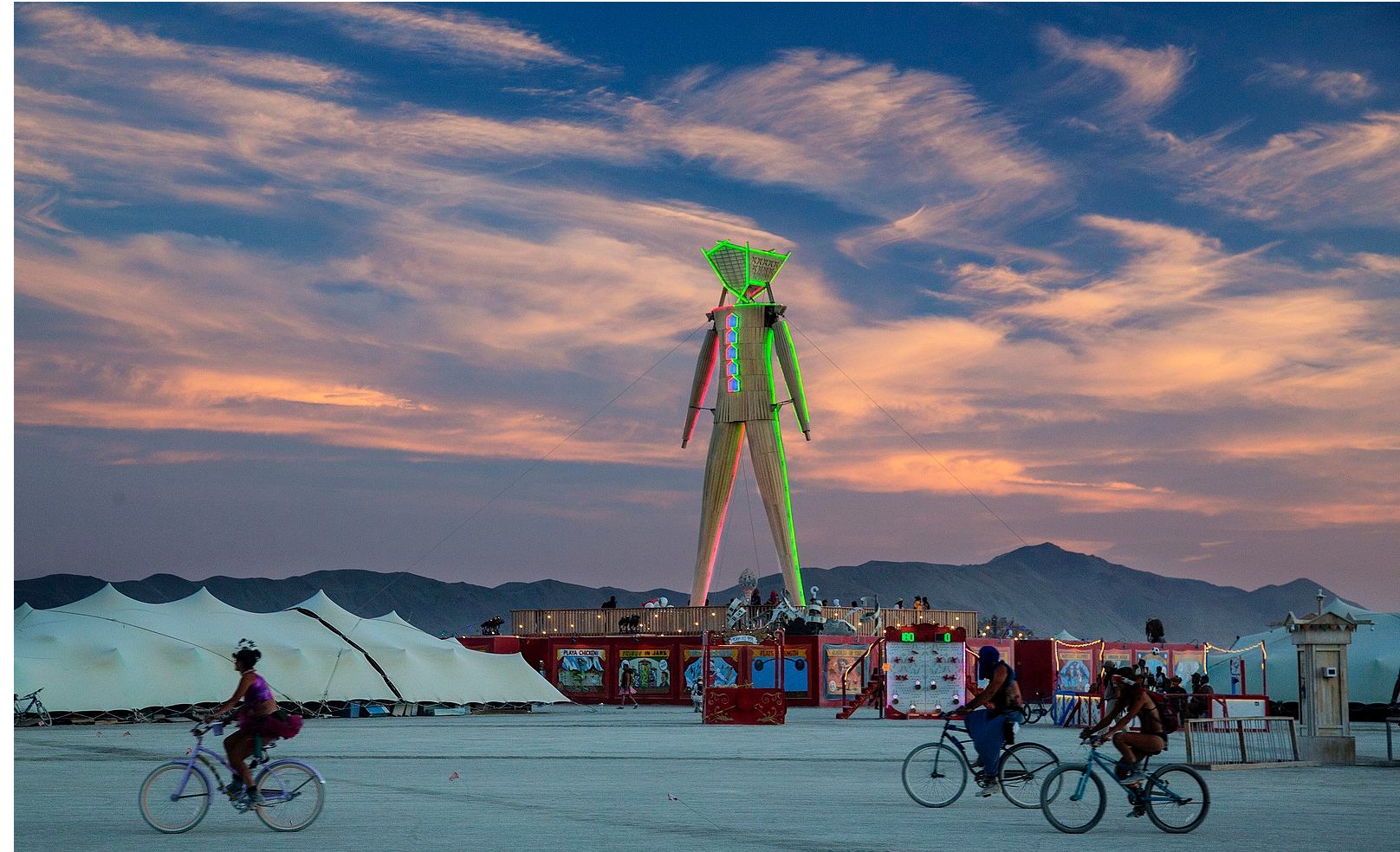Burning Man, we need to talk

Reno’s relationship with Burning Man, and vice-versa, has always been… complicated.
To be fair, Reno’s relationship with itself (and, by “Reno,” I’m including Sparks - speaking as someone who can see Sparks City Hall from my kitchen window, this pains me too, but look, most of what we think is in “Las Vegas” isn’t, so, as Nevadans, we’re just going to have to struggle through this in solidarity together) has always been complicated. Unlike Las Vegas, Reno’s always had reasons to exist beyond being a place where people from out of state can legally embrace their vices. The weather is habitable without air conditioning, though summer is admittedly more comfortable with it, and though it snows in Reno, it rarely sticks long enough to inconvenience anyone. The Sierra Nevadas, drained through Lake Tahoe, Washoe Lake, the Truckee River, and Steamboat Creek, provide enough water to support irrigation. Reno’s naturally positioned to support travelers as they either take a break before going over one last mountain range to enter California or as they take a break after leaving, especially with transcontinental railroads and highways passing through.
Trouble is, Reno may have reasons to exist, but, without vice, it’s rarely had a reason to prosper.
Reno’s history is one of repeatedly booming into respectability, busting harder than most, then pulling out and prospering again by being willing, if somewhat begrudgingly and reluctantly, to accept what other places won’t. Quickie weddings and divorces brought Reno out of the Great Depression. Gambling helped Reno and Sparks endure the loss of the Union Pacific yards in the 1950s after diesel locomotives and control electrification made them obsolete. However, unlike Las Vegas, which adopted a Thelemic (“Do what thou wilt shall be the whole of the Law”) attitude toward vice, Reno drew a red line around its gambling district and announced that vice will go that far - and no farther.
Well, no farther, that is, unless someone came in with a large sack of money and a promise to put Reno on the map. Then, pardon the expression, all bets were off.
When Burning Man came to Northern Nevada in the late 20th century, it caught Reno during another one of its bust cycles. While Las Vegas was demolishing casinos for New Year’s Eve to make room for bigger, splashier destination resorts, Reno’s casinos were quietly moldering away. At that time and in that context, getting a few thousand Burners to pass through Reno on their way to their bacchanalian festival in the desert didn’t just seem like a good deal - it seemed like a lifeline. Besides, Burning Man would happen over 100 miles away; by comparison, the infamous Mustang Ranch was less than 10 miles from Reno City Hall.
What could go wrong?
The answer, much to everyone’s astonishment, has been - surprisingly little. Burning Man brought a different crowd through Reno, one that wasn’t looking for a low-budget Las Vegas. Where past visitors looked at the King’s Inn and despaired, the Burners saw a pleasant potential base camp with plenty of affordable and empty warehouses to work in. In time, some of them stopped visiting and started living here instead, bringing the same artistic spirit and work ethic from the playa into the community.
In many respects, the Reno of today would not be possible without Burning Man - and therein lies the problem.
Reno is, yet again, experiencing a boom cycle. Like all past booms, Reno’s current boom has produced winners, losers, and messes to clean up. This time around, the winners are predominantly well-heeled Californians looking for a more affordable place to live, work, hike and play in - or the lucky few Reno natives that know how to signal their “cultural fit” into the Bay Area-lite professional environments of modern-day Reno. The losers, on the other hand, are those who came here during Reno’s gaming heyday in the ‘70s and ‘80s and remember when Reno was affordable in general, not just compared to the Bay Area. They also remember when “cultural fit,” as far as Reno went, meant $1 blackjack, $3 cocktails, $5 steak and eggs, and the only dress code was your ability to pay.
Say what you will about Reno, but Reno wasn’t pretentious - past tense intentional.
As for messes, well, Burning Man is experiencing a boom as well, and Reno’s residents have noticed for quite some time that Burning Man’s MOOP (Matter Out Of Place - trash, in other words) policy has the nasty habit of stopping in some Burners’ minds the instant they come back from the playa. Though Black Rock City, the non-profit that organizes Burning Man every year, enjoys trumpeting its ability to pick up after itself in the playa every year, Reno residents have watched with consistently increasing dismay as Burners fill every commercial dumpster (and several residential ones) on their way out.
Meanwhile, in much the same way that Reno is less the sort of place that someone can “show up as they are” and feel comfortable than it used to be, Burning Man has long since abandoned any pretense of being a few thousand hippies dancing in the desert on the cheap. What might be tolerable behavior coming from a few thousand stoned and sun-baked party-goers becomes much less understandable, and much more infuriating, when it’s coming from 80,000 rich celebrities and tech entrepreneurs. This gets doubly infuriating when it seems like some of the same rich people that can’t even clean up their own trash are becoming local landlords and raising rents into low Earth orbit.
To be fair to Burning Man, it’s hard to tell which Bay Area transplant is a Burner and which Bay Area transplant is just another Bay Area transplant.
The good news is Burning Man sees part of the problem. The bad news is, the idea that Burning Man can issue a cultural course correction away from becoming another Coachella or Fyre Festival - another festival full of entitled, affluent people looking to have fun at everyone else’s expense - seems, to a lot of us on the outside, as an idea that would have been better to have before they tried to relocate the event to Pyramid Lake in the rain and before someone left thousands of bikes and a Boeing 747 fuselage on the playa. Granted, the 747 fuselage was an art project that was successfully permitted, put together, and torn down (if a bit slowly on all counts), but more than a few locals would like to know who thought it would be a good idea to put it out there in the first place.
The good and bad news is the Bureau of Land Management has been listening.
Like Burning Man, the BLM is not known for its exemplary behavior. A few years back, for example, the BLM famously demanded 24-hour access to ice cream and a $1 million VIP compound while patrolling Burning Man. This time around, however, the BLM isn’t asking for improved creature comforts - instead, the BLM’s Environmental Impact Statement calls for searches of all event attendees and an illegal substance policy.
What’s missing from Black Rock City’s detailed rebuttal to the BLM’s demands, however, is that, per both Volume 1 and Volume 2 of the BLM’s Environmental Impact Statement, those demands are only required if Burning Man grows (Alternative A - increase the size of Burning Man to 100,000). If Burning Man merely stays the same size (Alternative D - “the same population cap (80,000), durations, and conditions as the 2018 Event”), searches for forbidden items at the gate and the illegal substance policy are no longer required.
It’s rare to find a government agency with less credibility and goodwill with Nevadans than the BLM. Politicians and op-ed writers have built careers in this state by haranguing against the dead bureaucratic hand of the BLM on the vast majority of Nevada’s lands. However, as bad as the BLM’s reputation is, Burning Man’s reputation isn’t anywhere near as good as it used to be, especially among those that have to clean up after it. As others have pointed out, nobody’s forcing them to invite over 80,000 people to the desert for a week.
For over two decades, Burning Man has been treated by the community as something of an eclectic church social that’s gone a little rogue. These days, however, Burning Man has far more in common with large destination events like the Electric Daisy Carnival. It costs a lot of money to attend, it draws a large crowd, and, far more often than Burning Man likes to admit, it’s a place to be seen by the right people. If Burning Man refuses to face reality and continues to insist that it be treated like a church social, it’s going to burn through whatever goodwill it has left.
For now, at least, the idea of Reno without Burning Man seems almost unimaginable. Burning Man has been a big part of what has made Reno into what it is today. However, it’s difficult to imagine anywhere else putting up with Burning Man these days and Reno needs Burning Man a lot less than it used to. If Burning Man is going to continue to turn into a playground for spoiled rich people that refuse to clean up after themselves, it’s going to find itself treated accordingly.
David Colborne has been active in the Libertarian Party for two decades. During that time, he has blogged intermittently on his personal blog, as well as the Libertarian Party of Nevada blog, and ran for office twice as a Libertarian candidate. He serves on the Executive Committee for both his state and county Libertarian Party chapters. He is the father of two sons and an IT professional. You can follow him on Twitter @DavidColborne or email him at [email protected].
